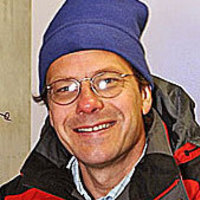Charles C. Jones Seminar
Neal Iverson, Professor of Geological Sciences
Title: Glacier sliding: creeping toward better constitutive rules
Abstract:
Glaciers deform as creeping viscous fluids but, unlike most fluids, can slip over their beds. This slip causes fast glacier flow that helps destabilize ice sheets and raise sea level. Model predictions of glacier speed depend sensitively on parameterized laws for glacier sliding that relate the drag at glacier beds to sliding speed and effective pressure. These laws—distilled from highly idealized theories of sliding—have widely disparate forms that cause divergent model predictions. Laboratory experiments with a custom rotary device allow testing of sliding laws for the cases of temperate ice resting on a rough, rigid bed (“hard” bed) or on a layer of water saturated till (“soft” bed). Ice-bed separation in experiments with undulating hard beds causes rate-weakening drag, such that drag peaks and then decreases significantly with increasing sliding speed. This behavior has potentially profound implications for glacier-flow instability. Experiments with soft beds indicate that the Coulomb strength of the shearing bed regulates drag that is independent of sliding speed, except at low speeds when slip of ice at the bed surface causes rate-strengthening drag. Our results indicate that Weertman-style (i.e., rate- strengthening) sliding rules—applied almost universally in numerical models of ice-sheet dynamics—may seriously underestimate flow velocities due to basal sliding. Modeling of ice flow in the boundary layer where basal sliding occurs and including 3D bed morphology, ice-bed separation, and effects of debris will allow a full assessment of sliding-law uncertainty, with potentially sobering results.
Bio:
Neal R. Iverson is a Professor of Geological Sciences at Iowa State University. He received his Ph.D. from the University of Minnesota in 1989. His research team uses laboratory experiments, field observations, and theoretical models to study processes that affect glacier flow, glacial erosion and sedimentation, and glacial landform genesis. His current research focuses on glacier sliding, the rheology and permeability of temperate ice, glacial erosion, and the genesis of drumlins. He has been a Fulbright Scholar and the recipient of 17 NSF grants as a lead PI. In 2011, he and four of his students received the Geological Society of America’s Kirk Bryan Award, and in 2017 he was awarded GSA’s Arthur L. Day Medal for the application of physics to geoscience.
